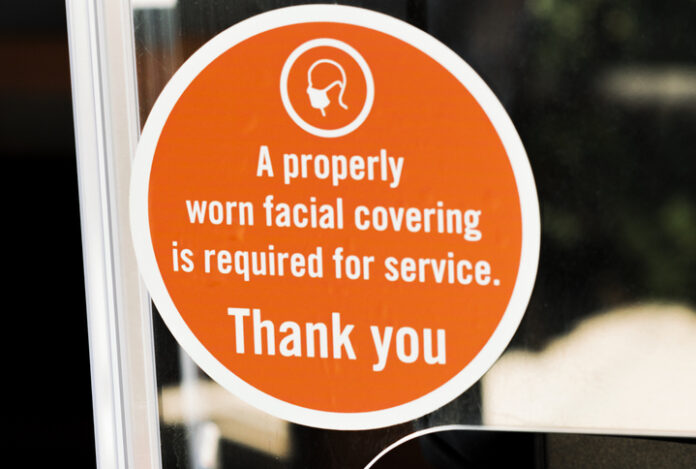An article published in the New England Journal of Medicine (NEJM) in May is getting renewed attention because it stated “wearing a mask outside health care facilities offers little if any, protection from infection.”
Thirteen days after publication, the researchers wrote a clarification to that line in a letter to the editor stating, “as the rest of that paragraph makes clear, we intended this statement to apply to passing encounters in public spaces, not sustained interactions within closed environments.”
The remainder of the paragraph states the following: “Public health authorities define a significant exposure to COVID-19 as face-to-face contact within six feet with a patient with symptomatic COVID-19 that is sustained for at least a few minutes (and some say more than 10 minutes or even 30 minutes). The chance of catching COVID-19 from a passing interaction in a public space is therefore minimal. In many cases, the desire for widespread masking is a reflexive reaction to anxiety over the pandemic.”
Twitter Picks up Article
Author Michael Klompas, M.D., M.P.H. of the Harvard Medical School told Health Care News he and his fellow writers felt the need to write the response due to several readers who took the statement out of context and twisted its meaning.
“[The article] was picked up by an anti-mask Twitter feed,” Klompas said. “The intent was to take our article out of context and was not a reflection of where current knowledge stands.”
Klompas says the letter to the editor was not a retraction. In fact, Klompas says he and the other writers were not pressured to write the letter of clarification and he stands by the article today.
“There was no pressure,” Klompas said. “My colleagues and I are very pro-mask.”
Despite the article in question and growing evidence showing masks alone have little effect in stopping transmission of the virus that causes COVID-19, governments all over the world have ramped up mask mandates. Businesses and private organizations in the U.S. have ordered customers, employees, and visitors to mask up for fear of fines or lawsuits.
Intention: Increase Masking
The May 21 article, entitled “Universal Masking in Hospitals in the Covid-19 Era was written to increase masking, not decrease it, and to review universal masking in health care settings, Klompas says.
“The state of knowledge at the time was based on influenza studies,” Klompas said. “It was difficult to find data proving the impact of masking. Our letter written to the NEJM was to clarify that.”
New studies from the U.S. Centers for Disease Control and Prevention (CDC) and researchers in Denmark have shown masks have had little effect in stopping transmission of the COVID-19 virus, but Klompas says it is important to note the context.
“[The Danish study] looked at virus coming in, not addressing virus coming out,” Klompas said. “Plus, the rate of viral infection in [Denmark] at the time of the study was very low and the only way they could test protection was with antibody studies, which are subject to false positives and negatives and corrupt the signal.”
Why Virus Remains with Masks
Mask mandates in the United States have been in place for months, and cases are at peak levels.
Klompas acknowledges the limitations of masks in stopping a virus.
“There are many factors related to transmission,” Klompas said. “Masks are one factor. A mask alone won’t be perfect protection.”
Masks also force users to touch their faces more often, but Klompas says he doesn’t think that is a reason not to recommend masks.
“When I put on a mask, I’m not putting my hands inside my mouth or up my nose. I put the loops around my ears, not licking the mask,” Klompas said. “I’m a bigger worrier that you have a cloth mask and never wash it and that being a breeding ground for bacteria. I haven’t, however, seen much evidence of harm from that.”
Masks as a Talisman
Klompas and the co-authors state in their article that there is a purpose for masks unrelated to providing a shield against a virus.
“It is also clear that masks serve symbolic roles,” the authors write. “Masks are not only tools, they are also talismans that may help increase health care workers’ perceived sense of safety, well-being, and trust in their hospitals. Although such reactions may not be strictly logical, we are all subject to fear and anxiety, especially during times of crisis.”
AnneMarie Schieber (amschieber@heartland.org) is the managing editor of Health Care News.
Internet info:
Michael Klompas, M.D., M.P.H., Charles A. Morris, M.D. M.P.H. Julia Sinclair, M.B.A., Madelyn Pearson, D.N.P., R. N, Erica S. Shenoy, M.D., Ph.D., “Universal Masking in Hospitals in the Covid-19 Era,” New England Journal of Medicine, May 21, 2020: https://www.nejm.org/doi/full/10.1056/NEJMp2006372




















[…] A similar retraction occurred in 2020 when authors in the New England Journal of Medicine wrote a disclaimer about their article questioning the effectiveness of masks in controlling viruses in public […]